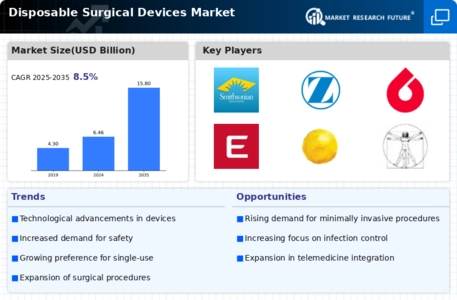Market Analysis
In-depth Analysis of Disposable Surgical Devices Market Industry Landscape
The market dynamics of disposable surgical devices reveal a rapidly evolving landscape shaped by technological advancements, increased awareness of infection control, and a surge in surgical procedures worldwide. Disposable surgical devices, including scalpels, forceps, and drapes, are gaining prominence due to their convenience, cost-effectiveness, and role in minimizing the risk of infections in healthcare settings. One of the driving forces behind the growth of this market is the escalating number of surgical procedures globally. As the demand for surgeries continues to rise, healthcare providers are increasingly opting for disposable surgical devices to ensure a sterile and safe environment, ultimately reducing the risk of cross-contamination.
Technological innovations have been pivotal in shaping the market dynamics of disposable surgical devices. Manufacturers are incorporating materials and designs that enhance the performance of these devices, ensuring both efficacy and safety during surgical procedures. The development of advanced materials, such as antimicrobial coatings and biodegradable polymers, addresses the need for infection control and environmental sustainability. These innovations not only cater to the evolving preferences of healthcare professionals but also contribute to the overall growth of the disposable surgical devices market.
The global emphasis on infection prevention and control in healthcare settings is another significant factor propelling the market. The disposable nature of these surgical devices minimizes the risk of healthcare-associated infections, which remains a critical concern globally. Healthcare facilities are increasingly adopting disposable surgical devices as a standard practice to mitigate infection risks, particularly in high-risk environments such as operating rooms. This heightened focus on patient safety and infection control has become a major driver in the widespread adoption of disposable surgical devices across various medical disciplines.
Moreover, the economic considerations associated with disposable surgical devices contribute to their increasing market share. While the initial cost of disposable devices may be higher than their reusable counterparts, the overall cost-effectiveness becomes apparent when factoring in sterilization, maintenance, and the risk of potential infections associated with reusable instruments. This economic rationale, coupled with the convenience of single-use devices, has led to a notable shift in preference among healthcare professionals and institutions, boosting the demand for disposable surgical devices.
The competitive landscape of the disposable surgical devices market is characterized by the presence of established medical device manufacturers and a continuous influx of new entrants. Market players are investing in research and development to introduce innovative products that cater to specific surgical needs. Customized disposable devices for specialized surgeries, along with eco-friendly solutions, are emerging trends that contribute to market diversification and growth. Companies are also focusing on strategic collaborations and partnerships to expand their product portfolios and geographical reach.
Despite the positive trajectory, challenges such as environmental concerns related to the disposal of single-use devices and the need for stringent regulatory compliance pose considerations for market players. Manufacturers are exploring sustainable materials and disposal options to address environmental impact concerns, while regulatory adherence remains crucial to ensure product safety and quality.

















Leave a Comment